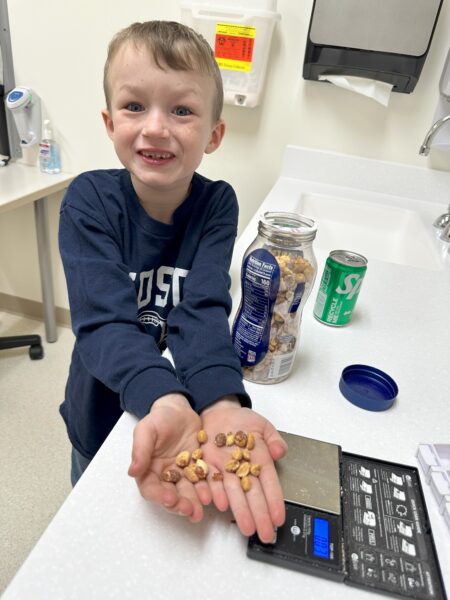
Since starting on oral immunotherapy, Harrison Huntington (center) is now able to eat ice cream without fear of a severe allergic reaction to peanuts.
Ever since Harrison Huntington, age 7 of Hudson, Ohio, was diagnosed with a peanut allergy, his parents hoped for a way to lessen the severity of his allergic reactions. Their hope became a reality when an oral immunotherapy (OIT) was approved by the U.S. Food and Drug Administration (FDA) in 2020.
“We knew we wanted Harrison to try OIT as soon as he could,” said Leesa Huntington, Harrison’s mom. “When Harrison came into contact with peanuts in any amount, he had a severe allergic reaction, including anaphylaxis. We heard that OIT could potentially help to desensitize him to peanuts and allow him to tolerate them in greater doses.”
While Harrison’s family waited for OIT to be broadly distributed, they managed his peanut allergy through regular visits to his pediatric allergist, monitoring what he ate, avoiding certain restaurants and foods and always carrying several EpiPens.

Oral immunotherapy (OIT) has helped lessen the fears of Justin Huntington, MD, Akron Children’s pediatric general surgeon, and his family. Dr. Huntington’s oldest son has a severe peanut allergy that is managed with OIT.
His share of scares
Since his peanut allergy diagnosis at six months old, Harrison has had numerous allergic reactions. Once, while crawling around on the kitchen floor after the family dog ate medicine hidden in a peanut butter-flavored pill pocket, he broke out in hives. Another time, he ate granola that had been processed in a facility that also processed nuts, which caused him to go into anaphylactic shock. Even food made using a cutting board and kitchen mixer that were cross-contaminated caused his allergic reactions.
“Any family that has a child with a severe food allergy knows how fearful life can be whenever that child is around food,” Leesa said. “We’ve cautioned Harrison about what he eats at school or a birthday party, but he’s young and learning how to handle situations. Still, as a parent watching your child go through this, it hurts your heart.”
Getting started on OIT
Harrison started on OIT when Akron Children’s Center for Allergy and Immunology began its oral immunotherapy program for peanut and cashew allergies in 2021. The Huntingtons learned that OIT demands a big commitment from families, including regular bi-weekly appointments that can last months and a willingness to follow a strict, at-home regimen for daily OIT dosing.
Oral immunotherapy is a process that involves feeding an allergic child an increasing amount of peanuts or cashews with the goal of increasing the threshold that triggers a reaction. According to the American Academy of Allergy, Asthma & Immunology, there are numerous safety and practical considerations. The twice-a-month office visits are used to assess how well the child tolerates increased doses. Additionally, the family monitors for symptoms after taking the at-home daily dosing of peanut or cashews. Families are advised to take certain precautions, including no exercise or hot showers for at least 2 hours after the dose, which can lower the threshold for anaphylaxis. Even losing a tooth affects the treatment.

Harrison Huntington shows the peanuts he would eat while at one of his bi-weekly allergy and immunology appointments. During the twice monthly appointments and an at-home regimen, he built up his tolerance to peanuts through OIT.
“While there are lifestyle considerations with OIT, one study in young infants showed that 21 percent of patients on higher maintenance doses achieved full remission of their peanut allergy and a more impressive 71 percent achieved desensitization or the ability to tolerate a set dose of peanut protein,” said Lisa Sammon, DO, Harrison’s pediatric allergist/immunologist and Allergy and Immunology interim director. “So far, we’re seeing the best outcomes in OIT in the preschool through early elementary school population. In those specific age groups, there is the best chance to modify the immune system.”
Finding success with OIT
With OIT, it’s important to know what the patient and family hope to achieve, especially since OIT isn’t a cure.
“It’s important to know what the patient’s final goals are,” Dr. Sammon said. “Some patients want to avoid peanuts entirely. Others want to incorporate peanuts into their lives to some degree and yet some others may want to be able to eat peanuts freely without experiencing anaphylaxis, which would require a higher maintenance dose. Ultimately, we have to individualize each person’s treatment because there is no one-size-fits-all to OIT.”
For the Huntingtons, OIT involved the whole family, even the younger children who spent hours at Akron Children’s during Harrison’s appointments. Over the course of nine months, Harrison went from experiencing severe allergic reactions to where he is now: eating two grams of peanut protein daily to maintain his tolerance.
There were times when Leesa felt scared because of how Harrison sometimes struggled while increasing his exposure to peanuts during OIT. At times, he had an allergic reaction, such as breaking out in hives or stomach cramping. But Harrison never wanted to quit. He saw his end goal.
“I asked him if it was worth all the appointments,” Leesa said. “He said, ‘Absolutely! Because I actually like the taste of peanuts and now, I get to eat stuff I used to not be able to, like Reese’s peanut butter cups and peanut M&M’s!”










